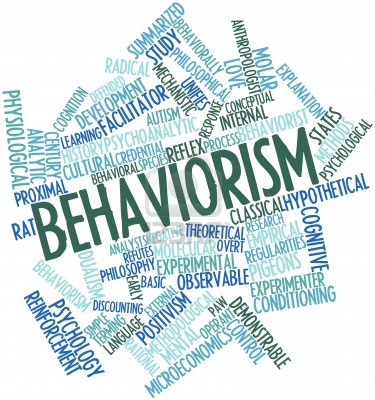Jay Doubleyou: behaviourism >>> krashen... pinker... skinner...

Behaviorism - Wikipedia, the free encyclopedia
It is indeed everywhere:

Is it time to bring behaviourism back into strategies? | Brandmaster
It's also in the classroom:

Educational Psychology in the Classroom
The behaviourist orientation to learning. The behaviourist movement in psychology has looked to the use of experimental procedures to study behaviour in relation to the environment.
John B. Watson, who is generally credited as the first behaviourist, argued that the inner experiences that were the focus of psychology could not be properly studied as they were not observable. Instead he turned to laboratory experimentation. The result was the generation of the stimulus-response model. In this the environment is seen as providing stimuli to which individuals develop responses.
In essence three key assumptions underpin this view:
- Observable behaviour rather than internal thought processes are the focus of study. In particular, learning is manifested by a change in behaviour.
- The environment shapes one’s behaviour; what one learns is determined by the elements in the environment, not by the individual learner.
- The principles of contiguity (how close in time two events must be for a bond to be formed) and reinforcement (any means of increasing the likelihood that an event will be repeated) are central to explaining the learning process. (Merriam and Caffarella 1991: 126)
Researchers like Edward L. Thorndike build upon these foundations and, in particular, developed a S-R (stimulus-response) theory of learning. He noted that that responses (or behaviours) were strengthened or weakened by the consequences of behaviour. This notion was refined by Skinner and is perhaps better known as operant conditioning – reinforcing what you want people to do again; ignoring or punish what you want people to stop doing.
In terms of learning, according to James Hartley (1998) four key principles come to the fore:
- Activity is important. Learning is better when the learner is active rather than passive. (‘Learning by doing’ is to be applauded).
- Repetition, generalization and discrimination are important notions. Frequent practice – and practice in varied contexts – is necessary for learning to take place. Skills are not acquired without frequent practice.
- Reinforcement is the cardinal motivator. Positive reinforcers like rewards and successes are preferable to negative events like punishments and failures.
- Learning is helped when objectives are clear. Those who look to behaviourism in teaching will generally frame their activities by behavioural objectives e.g. ‘By the end of this session participants will be able to…’. With this comes a concern with competencies and product approaches to curriculum.
Behaviourism
Bad News: Noam Chomsky
Behaviourism has given us learning outcomes/objectives:
A learning outcome is a description of what a learner will have learnt at the end of a period of study. Learning outcomes in theory can encapsulate a wide range of knowledge types skills and behaviours. We can thus have learning outcomes that describe: particular skills, such as operating a microscope, ways of thinking, such as analyzing, ways of behaving, such as respecting clients and the possession (de novo) of good old fashioned declarative knowledge.
The Learning Outcome in Higher Education: Time to think again?
A Critique of Instructional Objectives
James McKernan*
Education Inquiry Vol. 1, No. 1, March 2010, pp.57–67
Abstract
The ‘objectives model’ of curriculum planning, predicated upon behavioural performances, has become the dominant form of curriculum planning in Europe and elsewhere in the world. This paper argues that the objectives model is satisfactory for training or instruction, but falls down when applied to a true sense of ‘education’. The paper outlines 13 limitations on the use of educational objectives. It is argued that those interested in using objectives are guided by evaluation as assessment rather than principles of procedure for education. Education is about the process of ‘travelling’ on an educational journey – not about ‘arriving’ at a destination.
The idea of planning a curriculum with objectives has been prominent since the time of Franklin Bobbitt (Bobbitt, 1918; 1924) in American education. Indeed, Educational Psychology defines learning as demonstrable changes in human behaviour, and a whole host of writers have championed the use of behavioural/instructional objectives as performance targets as evidence for learning (Gronlund, 1970; Mager, 1962; Popham, 1968; Popham and Baker, 1970).
Benjamin Bloom suggested objectives to be “explicit formulations of ways in which students are expected to be changed by the educative process”(Bloom, 1956).
Mager, a leading advocate of behavioural objectives, argued: “an objective is a description of a performance you want learners to be able to exhibit before you consider them competent. An objective describes an intended result of instruction, rather than the process of instruction itself” (Mager, 1962). The Mager model recommended that objectives should be specific and measurable. Mager specified the three parts of an objective as follows: (1) it should have a measurable verb (an action verb); (2) it should include a specification of what the learner is given; and (3) it should contain a specification of criteria for success or competency.
The position adopted here is that instructional/behavioural objectives may be useful when working with the concepts of training or instruction but are unacceptable when dealing with the concept of education.
3. Objectives reduce education to an instrumental-utilitarian activity: taking a means to an end
Since the time of Frankin Bobbitt (1918; 1924) the idea of planning by objectives has been popular reaching a sort of zenith in the work of Ralph Tyler (1949) with his behavioural ‘objectives model’ that is seen as a teacher taking a means to a specified end. The idea behind this model is seen as changing the behaviour of the student – therefore any statement of purpose (objectives) is seen as changes taking place in the behaviour of students (Tyler, 1949:44). The most useful way of doing this is to select learning experiences and guiding teaching to achieve the objectives. This notion of Behaviourism as a guiding theoretical model has been the dominant force in curriculum-making, despite recent attacks discrediting Behaviorism as a sufficient theory of behaviour and of a model for curriculum (Sockett, 1973).
Conclusions
The objectives model seeks to provide the clarity of ends and is seemingly suitable for both training and instruction where skills and performances are paramount. However, the objectives model’s great problem lies in the area of induction into knowledge. From a moral point of view, the objectives model is arrogant and undemocratic in attempting to specify the behaviour of students in advance of instruction. Professor Herbert Kliebard (Kliebard, 1968:246) suggested that pre-specifying objectives amounts to indoctrination in the sense that it purports to stipulate how a person is to behave and then by attempting to control the environments so as to manipulate students into behaving as the teacher wishes them to.
www.lh.umu.se/digitalAssets/40/40552_inquiry_mckernan.pdf
See also:
The unhappiness principle | Times Higher Education
The Learning Outcome in Higher Education: Time to Think Again?
College Quarterly - Articles - Blooming Idiots: Educational Objectives, Learning Taxonomies and the Pedagogy of Benjamin Bloom
This is also the basis of the Common European Framework:
Common European Framework of Reference for Languages - Wikipedia, the free encyclopedia
The CEFR was developed to provide a common basis for the explicit description of objectives, content and methods in second/foreign language education.
The CEFR
- adopts an action-oriented approach, describing language learning outcomes in terms of language use;
- has three principal dimensions: language activities, the domains in which they occur, and the competences on which we draw when we engage in them;
- divides language activities into four kinds: reception (listening and reading), production (spoken and written), interaction (spoken and written), and mediation (translating and interpreting);
- provides a taxonomic description of four domains of language use – public, personal, educational, professional – for each of which it specifies locations, institutions, persons, objects, events, operations, and texts.
For reception, production, interaction, and some competences the CEFR defines six common reference levels (A1, A2, B1, B2, C1, C2), using “can do” descriptors to define the learner/user’s proficiency at each level.
The Common European Framework of Reference for Languages
The publishing industry is getting in on the act:
MAKING ENGLISH LANGUAGE LEARNING MORE EFFECTIVE – THE GLOBAL SCALE OF ENGLISH LEARNING OBJECTIVES | Pearson English
There isn't much criticism of it out there:
During the years since the CEFR was developed and published, criticism has arisen concerning the aims of the framework, its accessibility, description and classification of language competences, the number of competence levels, and application of the CEFR in language tests. Almost every aspect of the CEFR is vulnerable to serious criticism and yet, bearing in mind the extent of its reach, those language professionals who have criticised it in writing are relatively few in number.
THE IMPLEMENTATION OF THE COMMONEUROPEAN FRAMEWORK FORLANGUAGES IN EUROPEAN EDUCATIONSYSTEMS
Some criticism is addressed:
The Common European Framework of Reference for Languages:Insights for language testing
Cambridge ESOL exams and the Common European Frameworkof Reference (CEFR)
.
.
.

No comments:
Post a Comment